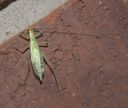Common Tree Crickets
Oecanthus
Classification
- Phylum: Arthropoda
- Subphylum: Hexapoda
- Class: Insecta
- Order: Orthoptera
- Suborder: Ensifera
- Infraorder: Gryllidea
- Family: Gryllidae
- Subfamily: Oecanthinae
- Genus: Oecanthus
Pronunciation
How to pronounce Oecanthus: //əʊˈkænθəs//
These audio files are automatically generated. While they are not always 100% accurate, they are a good starting point.
Images






Summary
Oecanthus (Common Tree Crickets) is a genus within the subfamily Oecanthinae, known for its green coloration and melodious calls, inhabiting North America's wooded and vegetated areas.
Physical Characteristics
Oecanthus species are characterized by their green coloration and distinctive ventral markings on the first two antennomeres. They possess long, slender bodies and long cerci, typical of tree crickets.
Identification Tips
Most Oecanthus species can be identified by examining the ventral markings on their first two antennomeres. There are multiple species that exhibit variations in coloration and markings, such as Prairie Tree Cricket and Black-horned Tree Cricket.
Habitat
Tree crickets are typically found in a variety of habitats including wooded areas, fields, and gardens, often in association with dense vegetation.
Distribution
Oecanthus species are widely distributed across North America, with around 18 species identified in the region and close to 90 species worldwide.
Diet
Tree crickets are herbivorous, feeding primarily on plant materials, including leaves and flowers.
Life Cycle
The life cycle of Oecanthus includes several stages: egg, nymph, and adult. The nymphs resemble small adults and undergo several molts before reaching maturity.
Reproduction
Females lay eggs in plant tissue or soil, and the eggs usually hatch in the spring. Mating occurs at night during the warmer months, with males attracting females by their song.
Predators
Natural predators of Oecanthus include birds, other insects, and spiders. They are also preyed upon by various small mammals.
Ecosystem Role
Oecanthus plays a role in the ecosystem as a herbivore and as prey for a variety of predators, contributing to the food web.
Cultural Significance
Tree crickets are often noted in folklore and culturally significant music and poetry, described for their distinctive sounds produced during mating season.
Collecting Methods
- Hand collection in the field
- Net sweeping in vegetation
- Using light traps at night
Preservation Methods
- Ethanol preservation
- Pinning for taxonomical study
- Storing in dry conditions with silica gel
Evolution
Oecanthus has evolved unique adaptations for their tree-dwelling lifestyle, including their long bodies and specialized call mechanisms for mating communication.
Misconceptions
Some people may confuse Oecanthus with other cricket species due to their similar appearances and sound patterns; however, Oecanthus is distinguished by its habitat preference and specific physical traits.
Tags
- Oecanthus
- tree crickets
- orthoptera
- insect
- environment